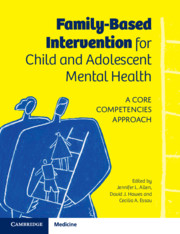Book contents
- Family-Based Intervention for Child and Adolescent Mental Health
- Family-Based Intervention for Child and Adolescent Mental Health
- Copyright page
- Contents
- Contributors
- Preface
- Part I Theoretical Perspectives on Family-Based Intervention
- Part II Core Clinical Competencies
- Part III Family Intervention for Specific Child and Adolescent Mental Health Problems
- Chapter 8 A Family-Based Approach to the Treatment of Youth Depression
- Chapter 9 A Family-Based CBT Approach to the Treatment of Anxiety Disorders in Children and Adolescents
- Chapter 10 Case Complexity and Resistance to Change in the Treatment of Child Conduct Problems
- Chapter 11 Enhancing Engagement and Motivation with Adolescents with ADHD and Their Parents
- Chapter 12 Functional Family Therapy for Antisocial Behaviour in Adolescents
- Chapter 13 Autism Spectrum Disorders in Young Children
- Chapter 14 Family-Based Treatment for Eating Disorders
- Chapter 15 Sleep Problems
- Part IV Family Intervention for Children at Risk Due to Family Dysfunction or Past Adversity
- Part V New Developments in Family-Based Intervention
- Index
- References
Chapter 10 - Case Complexity and Resistance to Change in the Treatment of Child Conduct Problems
from Part III - Family Intervention for Specific Child and Adolescent Mental Health Problems
Published online by Cambridge University Press: 18 February 2021
- Family-Based Intervention for Child and Adolescent Mental Health
- Family-Based Intervention for Child and Adolescent Mental Health
- Copyright page
- Contents
- Contributors
- Preface
- Part I Theoretical Perspectives on Family-Based Intervention
- Part II Core Clinical Competencies
- Part III Family Intervention for Specific Child and Adolescent Mental Health Problems
- Chapter 8 A Family-Based Approach to the Treatment of Youth Depression
- Chapter 9 A Family-Based CBT Approach to the Treatment of Anxiety Disorders in Children and Adolescents
- Chapter 10 Case Complexity and Resistance to Change in the Treatment of Child Conduct Problems
- Chapter 11 Enhancing Engagement and Motivation with Adolescents with ADHD and Their Parents
- Chapter 12 Functional Family Therapy for Antisocial Behaviour in Adolescents
- Chapter 13 Autism Spectrum Disorders in Young Children
- Chapter 14 Family-Based Treatment for Eating Disorders
- Chapter 15 Sleep Problems
- Part IV Family Intervention for Children at Risk Due to Family Dysfunction or Past Adversity
- Part V New Developments in Family-Based Intervention
- Index
- References
Summary
Case complexity and resistance to change have the potential to derail the successful treatment of child conduct problems in part through the effects they have on therapists. This chapter examines therapist competencies for responding to complexity and resistance to change in the evidence-based treatment of such problems. Key dimensions of case complexity among families of children referred for conduct problems are outlined, along with principles for adapting treatment plans based on these dimensions. A reflective practice model for overcoming resistance to change is then detailed. This process model, which draws heavily on principles from family therapy and research into parental resistance during the treatment of conduct problems, is designed to promote a shared therapeutic agenda and empower parents in the change process. Case examples and practical illustrations are presented throughout
Keywords
- Type
- Chapter
- Information
- Family-Based Intervention for Child and Adolescent Mental HealthA Core Competencies Approach, pp. 119 - 135Publisher: Cambridge University PressPrint publication year: 2021
References
- 3
- Cited by

